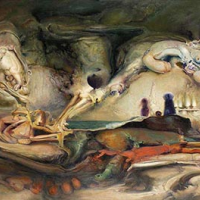JAMES GLEESON, Evening Ceremonies

James Gleeson carries the well-deserved mantle of being Australia’s first and foremost exponent of Surrealism. His practice commenced in the 1930s with Salvador Dali-inspired paintings and quickly evolved into his own unique style. This group of works from the estate of well-known gallery director Eva Breuer present a potent example of Gleeson’s immeasurable capacity as an artist to provoke, shock and surprise and are a high point in a majestic career that spanned over 60 years.
At the heart of Gleeson’s philosophy was the premise that art acted as a bridge between the rational and the irrational, that it represented an interface between the conscious, subconscious and unconscious mind. As art historian and curator Lou Klepac succinctly encapsulated, Gleeson ‘trawled the subconscious, chronicling the boundaries of human consciousness’.1
Gleeson reasoned that the role of the truly creative artist was to explore memories, associations, instinct and desire. In order to find out what lay beneath the physical world of external appearances surrealist artists quite literally tried to tap into the internal workings of their minds. Concentrating on works from the mid to late 1980s, the group of paintings and drawings represented here invite a concentrated focus on Gleeson’s own work and approach over a five-year period. This is a time in which his art transformed in ambition, character and scale.
In 1982 Gleeson decided to give up writing and lecturing to concentrate full-time on his art. A propitious annual holiday at Peregian Beach in Queensland resulted in a series of charcoal and collage drawings. After a period of gestation and reflection, these provided the basis for further exploratory drawings and an explosion of large works in oil.
Evening Ceremonies 1986, is a fine example of Gleeson’s large-scale paintings from that time that feature fantastic primordial creatures set in what seems like another world. Giant crustaceans, strange molluscs and other biomorphic and anthropomorphic shapes are assembled on the border between the land and the sea. As a young boy in Terrigal, on the New South Wales south coast, Gleeson marvelled at the geological formations, the surge of the ocean and the life-forms that were visible in the rocks and pools. These early memories provided a fertile visual cue for his work. They have also been linked to his interest in psychologist Carl Jung and the notion of a collective unconscious, as well as the origins of the sea as the birthplace for humankind.
Gleeson spent a lot of time thinking about titles for his work. They came later, after intense reflection, so as to avoid the works becoming overtly symbolic or prescriptive. Evening Ceremonies evokes rather than describes any specific event. The fluidity of the paintwork dissolves into liquid in the background while the foreground forms take on an equally mysterious air. A sense of threat is suggested by the way the creamy white organisms in the sky are separated, as if in a perpetual state of being torn apart. Gleeson commented that when he planned a picture he often thought in terms of colours – hot and cold, dark and light. This is a picture that he has made so luminous and contrasting that it exists somewhere between the two.